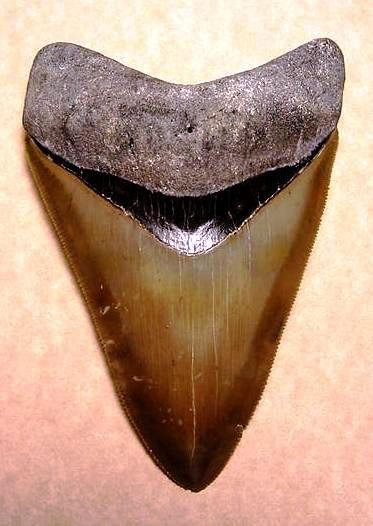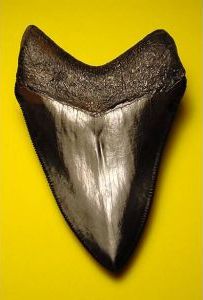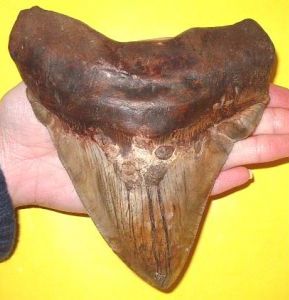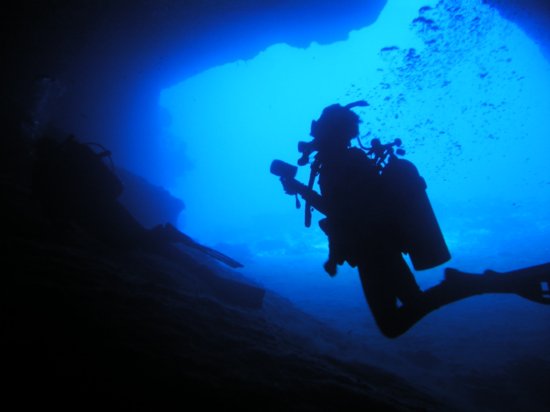 von megalodon_closeup.jpg)
History
Imagine a shark three times the size of the modern Great White shark charging with reckless abandon into a pod of enormous 30 foot Sperm Whales. The mighty fish opens its gaping jaws and crunches into the side of one of the swimming mammals, slicing through flesh, blubber, ribs, and vertebrae. A single 6" long ivory-white tooth is pried loose from the shark’s lower jaw and flutters down to the bottom of the ocean, stained red from the assault. The tooth hits the bottom and soon settles down in the soft mud. The tooth is slowly covered by the sediment until it is deep enough where it is cut off from the water and any oxygen that might creep through. 10 million years later a diver probes into the
bottom of a relatively modern river and uncovers this magnificent tooth,
now brown from the minerals that have penetrated it over the years.
This tooth, now a fossil but almost as sharp as the day it was lost,
becomes a prized possession for the lucky finder who hurries up to the
boat to show his friends. This tooth is, of course, from the largest
predator to ever inhabit the world’s oceans - Carcharocles megalodon. This ancient story relives itself day after day all over the world. Evidence of the megalodon shark can be found in fossilized teeth and vertebrae (even\ fossilized whale bones still showing bite marks from the attack) all over the world. The broad stratigraphic range of this shark (Eastern United States, California, South America, the Mediterranean, Europe, South Africa, Eastern Indian Ocean, Australia, Japan, and numerous other locals) indicates just how entrenched the megalodon was as top predator of the oceans. Carcharocles megalodon evolved from a long line of sharks stretching back about 60 million years. The first "true" ancestor appears to be Otodus obliquus, an extinct Mackerel shark which lived during the Paleocene- Eocene epochs (approximately 60-45 million years ago). This shark had large teeth (up to 4") with smooth cutting edges and large sidecusps on the side. Otodus obliquus began to evolve serrated edges (like a steak-knife) during the middle of the Eocene epoch (appx 45 million years ago). This serrated version was the first to bear the scientific name "Carcharocles". This shark, known as Carcharocles auriculatus, was the same size as its predecessor and had no real competition in the oceans. Eventually the shark began to grow to slightly larger sizes and a new scientific name was earned, Carcharocles angustidens. C. angustidens had teeth reaching to near 5" toward the end of its reign in the Late Oligocene/Early Miocene epochs (appx 18-25 million years ago). Then, probably due to the increase in whale sizes and the evolution of more modern types of whales, the megalodon was borne. The shark needed to grow to even larger sizes to dominate the food chain and it certainly succeeded. C. megalodon finally evolved during the Early Miocene epoch, about 18-20 million years ago. The shark began to reach unbelievable sizes and the largest sharks had teeth that were over 6" long, some even reaching an amazing 7" in length and over 1 1/2" in thickness! The shark probably grew to lengths over 60 feet and weighed as much as 20 tons or more. Please take a minute to think about the largest Great White Sharks that have ever been measured (maybe 20 feet and 2 tons) and picture just how large the megalodon actually appeared. Even the juvenile megalodon sharks had teeth equivalent in size to about a 15 foot adult Great White. While the main diet of the megalodon was almost certainly whales, there is also evidence that the shark fed on large fish, seals/sea lions, and probably giant squid.
Since the comparison has arisen to the modern Great White (Carcharodon carcharias), it should be clarified that the two sharks are probably not related in the least bit. While both sharks were the largest of their times, their teeth are superficially similar (somewhat), and they had a taste for the same types of food, they do not share any common ancestors. In fact the Great White Shark should probably be placed in with the Mako (Isurus) family as it almost certainly evolved from an extinct Mako shark named Isurus hastalis only a few million years ago. It was previously believed that the megalodon was the ancestor to the Great White and the previous scientific name given for the shark was Carcharodon megalodon. However, after many years of debate (some still ongoing), the name was officially changed to Carcharocles megalodon. Of course depending on location, the megalodon (meg-la-don - the "a" in "mega" is not often pronounced in typical conversation) could be called just about anything. In the Northeastern US the shark answers to the name (meg-ALO-don) but in Southwest Florida it is referred to as a "meggie". Whatever it’s called, a safe shortcut is simply to refer to it as "meg". In any case the megalodon had a lengthy reign as the king, almost 20 million years, thriving in temperate waters all around the world. However, toward the end of the Pliocene epoch (appx 2 million years ago), the megalodon mysteriously disappeared from the fossil record. While it is possible that certain isolated populations of sharks lingered on for a while longer, the vast majority of the megalodon sharks went extinct at this time. Several theories persist regarding the reason for the extinction but perhaps the most plausible is expressed by Bill Heim and Dr. Shelly Appelgate. They propose that whale evolution (in the form of improved tail structure/musculature) began to widen the gap between themselves and the megalodon. The whales were getting harder and harder to catch. Now, the common literature holds that the megalodon was an explosive, streamlined, very fast shark. While there was no doubt that it was a powerful and exhausting stalker, if the above theory proves true, the megalodon should not have been run around in circles while chasing down dinner. While nobody knows for sure exactly what the megalodon looked like, odds are that it was more robust and clumsy (being a relative term here) than has been previously thought. It must have had a somewhat quick burst of speed to be able to catch its prey (even if it often attacked by ambush) but if improved whale dynamics could enable the whales to escape unscathed, the megalodon would either have to evolve itself or die off. Apparently the megalodon chose the latter. So while the megalodon sharks vanished some 2 million years ago, their legacy still lives on in the form of fossils. Fossilized megalodon teeth are found in marine fossil deposits all over the world, but no where are they as commonly collected as in the Eastern United States. Throughout the lifespan of the megalodon, this entire region was near-shore and just off-shore oceanic waters. Some of the most famous fossil collecting areas are located in the Carolinas where rivers cut deeply into the ground exposing the fossil layer 20-30 feet below the surface. Here divers brave hazardous conditions such as zero visibility, strong currents, boat traffic, underwater obstructions, alligators, snapping turtles, and even modern sharks to collect these prehistoric treasures. Of course, the rewards of pulling up such a fascinating piece of history that tell such a great story is more than worth it to these die-hard collectors. It is strongly recommended, however, that amateurs stay out of these waters as there have been numerous life-threatening (and even life-taking) incidents - even the professionals are not immune. After two million years the megalodon still claims unsuspecting victims so please leave the diving to the professionals.
Not to worry if risking one’s life does not sound appealing enough for simply finding a fossilized megalodon tooth. There are certain quarry operations that expose the fossil layer while they are digging down in search of their primary pursuits, usually phosphate. Some of these companies are generous enough to allow access to fossil collecting on their private property. Unfortunately this has not always been the case and many once fossil-rich collecting sites have been closed down to the public. This blame cannot be lain upon the quarry operators, it must be given to the one or two bad seeds who do not follow the guidelines and expectations placed upon them (which are usually quite liberal and easy to conform to). Respect the rules and a memorable experience can be had by all. Once collectors are lucky enough to obtain a megalodon tooth they quickly learn why these teeth are the most talked-about centerpiece of any collection. The teeth are massive in both structure and size and well-preserved specimens still show the razor-sharp serrations which enabled the megalodon to command its territory. As previously noted, teeth are known to reach just over 7" in slant height (the official measurement which measures the total length between the tip of the tooth and the longest corner of the root). The largest teeth of the megalodon come from the front of the jaw while the teeth toward the rear of the jaw are the smallest. For example, an adult shark may have a 6" long front (anterior) tooth but only a 1 1/2" rear (posterior) tooth. The anterior teeth are usually fairly symmetrical while the teeth are much more angled the farther back in the jaw they go. Therefore, just because a tooth is only 1 1/2" doesn’t necessarily make it a posterior tooth from a large adult. It could very well be an anterior tooth from a juvenile. This is where the angle and thickness of the tooth must be studied to determine the tooth position and thus the relative size of the shark. Fortunately for the whales, the fossilized remnants are all that’s left of this once-powerful predator. Carcharocles megalodon was the largest shark to ever swim the world’s oceans and it unquestionably ranks as the most impressive as well. This was a shark that was as long as a large yacht and as vicious as any creature that ever existed. The legacy left by the megalodon will surely never be matched by any other living creature. No matter what you call it, it was definitely the biggest fish in a big pond.
|
||||||||





